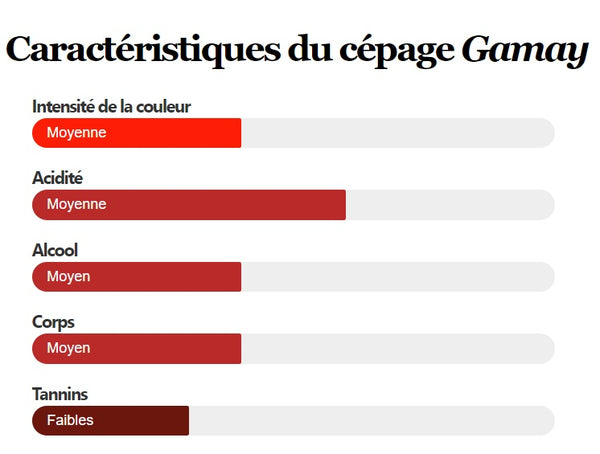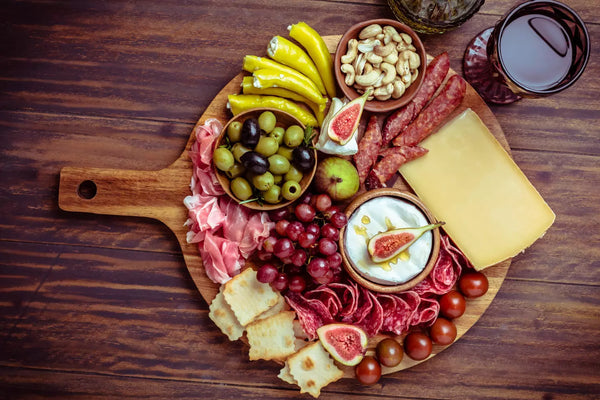Among the most emblematic grape varieties of France, the Gamay certainly stands out thanks to its centuries-old history as well as its delicious taste qualities.
Sometimes criticized (often due to misunderstanding or oversimplification), this variety nevertheless has many advantages, offering the enthusiast wines for pleasure as well as for gastronomy, capable of being enjoyed as an aperitif or during a meal.
Through this article, you will discover the fantastic history of Gamay, its main aromatic markers , and how and with what to taste it under ideal conditions.
So, pour yourself a glass...and happy reading!
History of Gamay
The Gamay, or "Gamay noir à jus blanc" (to distinguish it from its cousins) is the result of a crossing between the grape varieties Pinot noir and Gouais blanc. While the first is well known to enthusiasts and still today is the pride of the Burgundy vineyard, the second has nevertheless disappeared. It is also estimated that the Gamay would be originating from the commune of Saint-Aubin, located in Côte de Beaune, within the Burgundy.
Although it is very likely that its history is older than that, one finds the first written traces about it as early as the end of the 14th century.
It was indeed in 1395 that Philippe Le Hardi issued an ordinance aiming to ban Gamay from its native land with these words: « this Gamay wine is of such a nature that it is very harmful to men. […] several people who previously consumed it have been afflicted with serious illnesses ; for this wine which is produced and made with this plant, by its nature is full of a very great and unbearable bitterness […] for it emits a strong and unpleasant odor »
While the chosen words seem very exaggerated today, it must be kept in mind that at the time, in the viticultural world, quantity was favored over quality. As a result, and with Gamay being naturally very fertile, the high yields then practiced did not allow for the best to be drawn from this otherwise delightful grape variety.
Thus, from the end of the 14th century, Gamay was uprooted and banned from a large part of Burgundy to be replanted further south, in the Mâconnais as well as in the Beaujolais, where it acclimatized wonderfully to the climate and the granite and clay-limestone soils.
During the following centuries, Gamay continued to develop throughout France, covering more than 160,000 hectares (10% of the national vineyard!). Unfortunately, the arrival of phylloxera, the infamous pest that devastated European vineyards in the 19th century, caused it to disappear from almost all wine-growing areas.

Gamay Cultivation Areas
Even today, it is still within Beaujolais that the majority of Gamay vines are located. Thus, if there are 30,000 hectares of the variety worldwide, more than 50% is planted in Beaujolais. In the region, Gamay even covers 99% of the vineyard!
Moreover, while other wine regions also cultivate it, it is in much smaller proportions.Thus, Burgundy (especially in the Mâconnais) uses it, for example, within its appellations Coteaux Bourguignons, Bourgogne Passe-Tout-Grain or certain Crémants.
The Gamay is also found in the Loire to produce certain red wines, in Savoie, in Lorraine (AOC Côtes de Toul) or even in Auvergne (AOC Saint-Pourçain, Côte Roannaise etc.).
Abroad, it is well established in Switzerland where it is the third most cultivated red grape variety, as well as anecdotally in many countries such as Italy, the United States, South Africa, and even Australia.
The characteristics of Gamay
The Gamay is a grape variety primarily renowned for its production of red wines with low tannins, endowed with a lovely freshness, and developing on aromas of fresh red fruits (raspberry, strawberry, redcurrant, cherry, etc.). Most of the cuvées produced in Beaujolais are intended to be consumed in their youth (within the first 3 to 5 years).
In reality, this image of friendly wines represents part of the truth, and it is important to provide a nuanced view. Indeed, Gamay has the capacity to offer very different wines depending on the quality of the plant material, the age of the vines, the type of soil, the yields, or the winemaking method chosen by the winemaker.All these parameters indeed have a decisive influence on the quality of the wine you taste.
Thus, if you opt for a red wine in AOC Beaujolais or Beaujolais-Villages vinified using carbonic maceration (a winemaking method typical of the region), you will almost certainly have a fresh, colorful, and supplewine, expressing pronounced notes of tangy red fruits. The Beaujolais Nouveau, the first wine of the year marketed every 3rd Thursday of November, is the archetype.
Nevertheless, other Gamay wines exist. Thus, whether this grape variety is vinified using carbonic, semi-carbonic, or traditional maceration, it is also quite capable of offering concentrated, powerful wines and sometimes long-lasting aging potential.The aromatics of these Gamays will then tend more towards notes of ripe black fruits (black cherry, blackcurrant, prune), spices (pepper), and will also present a beautiful tannic structure. So be careful with shortcuts!
You will have understood, moreover, that in the middle of these two extremes, between light wine and powerful wine, Gamay also offers a myriad of possibilities for medium-aging wines (5 to 8 years), offering concentration and aromatic expression (red and black fruits, spices, violet, etc.) while maintaining freshness. Many appellation cuvées like Saint-Amour, Brouilly , or even Fleurie perfectly represent this balance.

Food and wine pairings and serving temperature
Given the different wine profiles that can be created from Gamay, many culinary possibilities are available to you depending on the vintage you choose.
With a Gamay that is light and fresh, a charcuterie platter is, for example, a must. Thanks to its acidity and suppleness, you can also easily pair this type of wine with cheeses like Comté, Beaufort , or even Brillat-Savarin. Finally, due to its low tannin concentration, it can also be combined with fish such as Cod or Sea Bream.
With a medium-bodied Gamay with an interesting concentration, we will then move on to pairings with white meat (roast chicken with herbs, roast turkey, veal blanquette, etc.).
Finally, with a powerful and tannic Gamay, red meat will then become necessary to support the intensity of the wine. Lamb chops, beef rib steak, game, etc.) will be excellent choices.
As for the appropriate serving temperature, it will also vary according to the wine's profile. Thus, for a fruity, concentrated, and slightly tannic Gamay, a relatively cool service between 14-16°C will be ideal.This can even drop to between 12-14°C for a Beaujolais Nouveau! However, with a powerful wine made from Gamay, a temperature between 16-18°C will be preferable in order to reveal its aromatic complexity and not tighten its tannins.

The best Gamays
Providing a list of the best Gamays is a very subjective exercise because it primarily depends on the type of wines you enjoy! Nevertheless, whether you like fruity and light red wines, rather round and with a certain intensity, or even powerful and long-lasting, you will find your happiness in the selection of
- Clos de la Roilette - Fleurie - Cuvée Tardive
- Domaine Cheveau - Saint-Amour - Villa Violettes
- Domaine Coudert - Brouilly
- Vignobles Bodillard - Beaujolais-Villages - 3B
- Vignobles Bodillard - Morgon - Marie-Louise
- Vignobles Bodillard - Morgon - L'Auguste X
You will have understood, therefore, that Gamay is a versatile grape variety offering delightful taste experiences.So do not limit it to Beaujolais Nouveau or simple light aperitif wines because, although such vintages from this grape variety are very pleasant, this variety is capable of offering you a very diverse range of wines, thus adapting to almost any occasion. Cheers!















